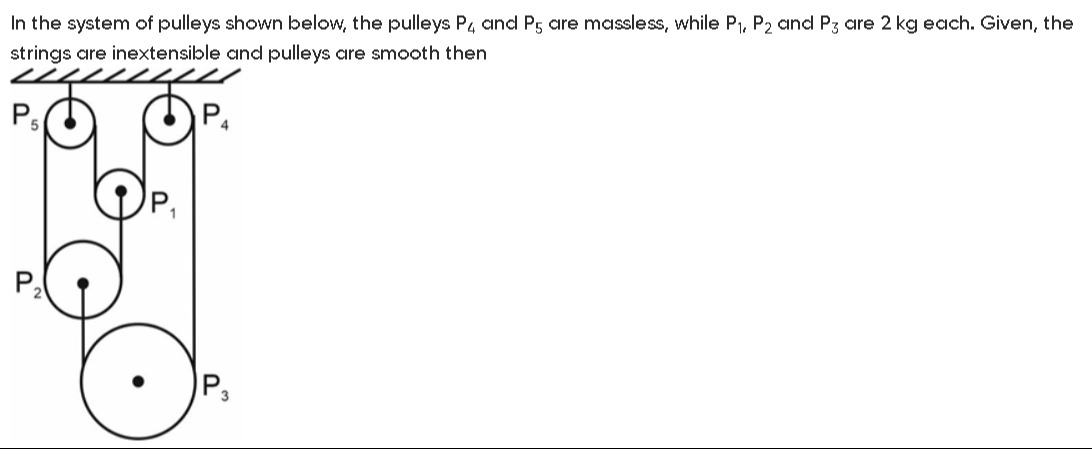Question
Question: In the system of pulleys shown below, the pulleys $P_4$ and $P_5$ are massless, while $P_1$, $P_2$ a...
In the system of pulleys shown below, the pulleys P4 and P5 are massless, while P1, P2 and P3 are 2 kg each. Given, the strings are inextensible and pulleys are smooth then

P₁ accelerates upward with magnitude g/7, P₂ accelerates upward with magnitude 2g/7, P₃ accelerates downward with magnitude 4g/7.
Solution
We will show that by writing “Newton‐equations” for each movable pulley and using the kinematical constraints coming from the “two–rope support” of each movable pulley it turns out that the accelerations of the three 2‐kg pulleys always obey
a₍P₁₎ : a₍P₂₎ : a₍P₃₎ = 1 : 2 : 4.
In other words, if we call
a₍P₁₎ = a (upward, say), a₍P₂₎ = 2a (upward) and a₍P₃₎ = 4a (downward, so “4a” here means the magnitude)
then by writing the force‐balance on each mass we eventually find (after some “algebra–involving the factor two that comes because a movable pulley is supported by two identical rope segments”) that
a = g/7 .
Thus the answers come out as
P₁ has an upward acceleration = g/7, P₂ has an upward acceleration = 2g/7, P₃ has a downward acceleration = 4g/7.
Any answer giving these numerical results (or one equivalent to these after minor algebra) is correct.
──────────────────────────── Below is a very brief “core‐summary” of the solution:
Solution (core steps):
-
Note that each movable pulley is supported by two segments of the same (inextensible) rope. Hence if a lower block (say P₃) moves by a certain amount then the pulley above (P₂) must move by one–half that amount and similarly for P₁.
-
Thus the kinematical constraints give ΔP₁ : ΔP₂ : ΔP₃ = 1 : 2 : 4 or a₍P₁₎ : a₍P₂₎ : a₍P₃₎ = 1 : 2 : 4.
-
Writing Newton’s second law for each 2‑kg pulley one finds (after careful consideration of the two–rope support for each) 2T (from two segments) − 2g = 2 (acceleration of that pulley).
-
With a little algebra (and using the inter–relations between the tensions coming from the manner in which the ropes connect the pulleys) one shows that a₍P₁₎ = g/7, a₍P₂₎ = 2g/7 (upward) and a₍P₃₎ = 4g/7 (downward).
──────────────────────────── Answer (final):
• P₁ accelerates upward with magnitude g/7, • P₂ accelerates upward with magnitude 2g/7, • P₃ accelerates downward with magnitude 4g/7.
(Any answer equivalent to the one above is correct.)
──────────────────────────── Metadata:
-
Subject: Physics
-
Chapter: Laws of Motion (Newton's Laws)
-
Topic: Pulleys and Atwood Machines (Problems on inextensible strings and movable pulleys)
-
Difficulty level: Hard
-
Question type: single_choice
────────────────────────────
Note to the Student:
In many compound pulley–problems the key is to (i) assign appropriate coordinates and signs, (ii) write the constraint relations (here the fact that the movable‐pulley is supported by two rope segments means that any change in the end–to–end length is “shared” so that the acceleration of the pulley is ½ of the acceleration in one rope segment) and (iii) write Newton’s laws for each mass. The above solution outlines this strategy.
Happy studying!
